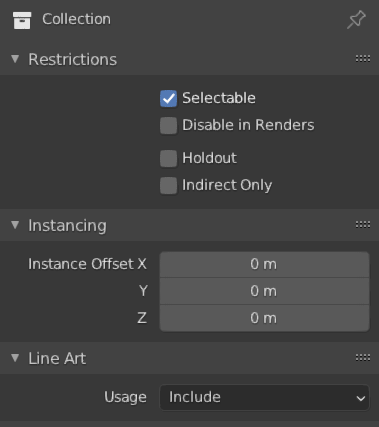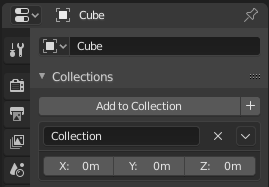Collections¶
There can be many objects in a scene: A typical stage scene consists of furniture, props, lights, and backdrops. Blender helps you keep everything organized by allowing you to group like objects together. Objects can be grouped together without any kind of transformation relationship (unlike parenting). Collections are used to just logically organize your scene, or to facilitate one-step appending or linking between files or across scenes.
Collections Tab¶
Referência
- Menu:
Collection properties tab allows convenient access to properties for the active collection.

Collection properties.¶
Restrictions¶
- Selectable
Toggles the ability to select the objects from the 3D Viewport. This is useful for if you have placed something in the scene and do not want to accidentally select it when working on something else.
- Disable in Renders
Enables/disables visibility of the collection in renders.
- Holdout
Objects inside this collection will generate a holdout/mask in the active view layer.
- Indirect Only
Objects inside this collection will only contribute to the final image indirectly through shadows and reflections.
Instâncias¶
- Instance Offset X, Y Z
Applies a spatial offset of the instanced collections from the original object’s origin.
Exporters¶
Each collection can be exported to a number of various file formats. These exporters are available globally, see Importando e exportando arquivos, however, this panel streamlines the process of re-exporting the same asset(s) repeatedly. For example when creating glTF assets for a game and iterating on the look, or when using Blender in a studio pipeline to create USD assets.
The following file formats are supported, see each for the documentation of export parameters:
- Exporter List
A list view of all the enabled exporters for the active collection. The selecting an exporter from the list will show it’s options in a sub panel below.
Exporters can be added/removed through the + and - icons to right of the Exporter list.
- Export All
Exports all exports for the active collection.
Dica
Use to export all exporters for all collections.
Line Art¶
- Uso
How the collection is loaded into line art. Child objects of the collection can override this setting if they wish in Object Properties.
- Include:
Generate feature lines for this collection.
- Occlusion Only:
Objects in the collection will only cause occlusion to existing feature lines and their geometry stay invisible.
- Exclude:
Objects in this collection will not be loaded into line art at all.
- Intersection Only:
Objects in the collection will only produce intersection lines in the scene and their own geometry stay invisible.
- No Intersection:
Include this collection but do not generate intersection lines.
- Force Intersection:
Generate intersection lines even with objects that disabled intersection.
- Collection Mask
Use custom intersection mask for faces in this collection. Intersection masks can be used by the Line Art modifier to filter lines. See Collection Masks for more information.
- Mask
Intersections generated by this collection will have this mask value.
- Intersection Priority
Assigns an intersection priority value for this collection. The intersection line will be included into the object with the higher intersection priority value.
Propriedades personalizadas¶
Create and manage your own properties to store data in the collection’s data block. See the Custom Properties page for more information.
Collections Panel¶
Referência
- Mode:
Modo de Objeto
- Panel:

Collections panel.¶
All collections that an object has been assigned to are listed in the Properties .
- Add to Collection
Adds the selected object to a collection. A pop-up lets you specify the collection to add to.
- Novo
+ Creates a new collection and adds the selected object to it.
- Nome
To rename a collection, simply click in the collections name field.
- (Remove Collection)
Removes the object from the specified collection.
- Especiais
Unlink Collection, Select Collection, Set Offset from Cursor
- Deslocamento
Applies a spatial offset of the instanced collections from the original object’s origin.
Veja também
Appending or Linking Collections
To append a collection from another blend-file, consult this page. In summary, Select a blend-file and then the collection.